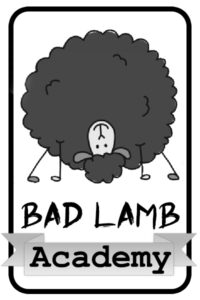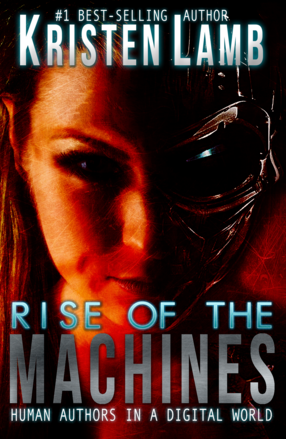Yes, even WANA International is offering a Black Friday special. Cool thing is? No leaving home or getting in a fist-fight…unless you want to. I’ve killed three people this morning (though as writers. it’s ALL legal). I’ve asked Lisa Hall-Wilson to come chat with you guys about a serious sticky-wicket for new writers especially. We need to know what is going on in the minds of characters, but if they go around talking to themselves non-stop? Readers just roll their eyes.
There is a BIG difference between narrative and internal dialogue, and Lisa is here to clear up the confusion!
Take it away!
*throws glitter*
Stephen King wrote in On Writing about the writer’s toolbox. Tools like vocabulary, punctuation, grammar, showing not telling – those all belong in the top level of your toolbox, but lift off that top shelf and there’s a bunch of other tools that are very necessary but relegated to the more advanced writer.
Internal dialogue is a tool in the bottom half of your toolbox.
Internal dialogue is the thoughts, dreams, stream-of-consciousness stuff inside a character’s mind only the reader is privy to. Most people talk to themselves, think in at least partial sentences, talk themselves into and out of all kinds of things, they weigh consequences, wrestle with past experiences all in their head in a split second. How many smart girls make bad decisions about men?
Without internal dialogue, understanding what the character is struggling with – how they arrive at their decisions – what motivates them, it’s very difficult for a reader to connect emotionally. Internal dialogue happens through all points of view – first person, third person, omniscient.
There are a lot of aspects to writing internal dialogue correctly that go beyond punctuation (which is what I get asked about the most – should I use italics or quotation marks?).
One of my favorite movies is While You Were Sleeping. This came out in 1995 so I’m using spoilers. If you haven’t seen it I’m calling Scrooge – too bad. Go watch it on Youtube. Seriously awesome movie.
Lucy is this slightly neurotic (aren’t we all) but loveable single lady who finds herself facing another Christmas alone. Her parents are gone, she has no family or siblings – and she’s asked to work Christmas AGAIN because she’s the only one without family.
This is the story’s main story arc. Lucy wants a family, to belong somewhere, more than anything else. We have to understand this internal conflict for the rest of movie’s antics to make sense. To understand why she makes the decisions she does – and what she sacrifices for that dream.
“Ever fallen in love with somebody you’ve never even talked to? Ever been so alone you spend the night confusing a man in a coma?”
We feel her pain. Who doesn’t know the pain of being alone? Being alone at Christmas is a double whammy – who can’t sympathize with Lucy? But she’s funny. Her self-deprecating humor doesn’t make her a tragic character – who wants to follow a story about a Debbie Downer?
This movie uses a lot of internal dialogue really well. The conflict of the movie kicks off when she saves a man from being squished and severed by an oncoming subway train. (A man she’s secretly fantasized about for a while.) She bungles yet another opportunity to start a conversation with the guy she’s been fantasizing about and after he’s walked away she says, “Nice coat. Merry Christmas to you, too. You’re beautiful. Will you marry me? I love you.”
She follows the ambulance to the hospital to make sure he’s OK. They won’t let her in to see him because – she’s not FAMILY. She’s standing on her own in the ER and says out loud to herself, “I was gonna marry him.” She’s trying to get her Christmas tree into her second-floor apartment through the window.
“Forty-five dollars for a Christmas tree and they don’t deliver? You order $10 worth of chow mein from Mr. Wong’s and they bring it to your door. Should’ve gotten the blue spruce – they’re lighter.”
Internal dialogue is not the same as narration though, and the two are often confused. Lucy does a fair bit of narration as well, so this is a good movie to watch to learn the difference. The movie opens with a Lucy-voiceover:
“OK. There are two things I remember about my childhood. I just don’t remember it being this orange. First, I remember being with my dad. He would get these far off looks in his eye and he would say, ‘Life doesn’t always turn out the way you plan.’
I just wish I’d realized at the time that he was talking about my life. But that never stopped us from taking our adventures together. He would pack up our sometimes working car and tell me amazing stories about strange and exotic lands as we headed off to exciting destinations like… Milwaukee – it’s amazing how exotic Wisconsin…isn’t.’”
You can watch the opening few minutes of the movie here:
This is narration. Lucy is talking directly to viewers not herself. What she’s talking about, revealing, she intends for others to hear. It would be like giving someone your diary to read, but sitting next to them and offering narrative context between each entry. Note the difference?
Take an hour and a half this season and watch the movie. Pick out all the places where Lucy talks to herself (because that’s how internal dialogue has to work in the movies). What do you learn about Lucy and her personal desires, the reasons she makes her decisions, why she doesn’t speak up. Does knowing what she’s thinking to herself make you root for her, feel her pain, cheer with her success, agree with the lies she tells?
I’m teaching a webinar on Beyond Basics: How to Write Effective Internal Dialogue on December 7 at 11AM ET. We’ll cover punctuation, the psychology of internal dialogue, tense dilemmas, and lots of other things, and I’ll have examples from best-selling novels to show you how it’s done.
This class is being offered as part of a WANA2fer. Save $20 when you register for my Internal Dialogue class and Marcy Kennedy’s How To Make Your Dialogue Shine on the same day at 2PM ET. Because it’s Black Friday, today only if you sign up for the Internal Dialogue class you can save 25% by using the code ‘lisasentme’ at registration.
About Lisa Hall-Wilson:
Lisa Hall-Wilson is an award-winning freelance writer, author, and journalist published across Canada. She specializes in social media administration, interviews, profiles, and social justice initiatives, and speaks at writer’s conferences. She’s passionate about making this world a better place one get-off-your-butt-and-do-something article at a time. She blogs Through The Fire at www.lisahallwilson.com and writes dark fantasy novels. She hangs out on Facebook A LOT.










24 comments
4 pings
Skip to comment form
Great advice, Lisa. Thanks for being on Kristen’s blog. ‘While You Were Sleeping’ is a great flick. Have seen it more than once. Never gave a thought to the difference between narrative and internal dialogue. Now I see what you mean. Not sure what I’ll be up to on the 7th, but will try to be a part of your class.
Hope you and yours had a Happy Thanksgiving! (The same goes for you and yours, Kristen!)
Really good advice, Lisa! I love that movie. Wish I could take your class, but I already have other plans that day. Thanks for guest posting today!
Hi Debbie,
That webinar will be recorded so if you can’t attend live you can still get the recording and handouts. 😀
One of my favorite movies and I love how it illustrates the difference.
I *love* this movie… Great advice 🙂
She makes it so simple: Talk to yourself= internal dialogue. Talk to the reader=narration.
Whose idea was it to make it complicated?
Great post. I need help with Internal dialogue. When I was learning to write a writer I admire told me how awful books were with too much internal dialogue and I spent too many of my early years not developing that skill because of that one piece of advice. Sigh. But I’m working on it now.
Good to hear that I can listen to a recording of the class. Do I still sign up the same way?
Yes! Thanks for reading, Trish.
Are there still people on earth who haven’t watched that show? That makes me incredibly sad for them. This was a great example. Thanks Lisa and Kristen!
Great explanation and example, Lisa, and I, too, love that movie. I know you will probably cover this in your class, but I do get tired of writing where the internal dialogue is there, clearly in italics, yet the author still finds it necessary to add “she thought” or “she wondered”. Internal dialogue does not need an attributive, as we know to whom it belongs. (smile)
Hello Kristen
You know how your blog is one of my very top favorites and I’m always happy to read your new posts!
Therefore I hope you’re happy to find out you deserve the “Blog of the Year 2013? Award.
I got you your first star:
http://raaniyork.wordpress.com/2013/11/29/blog-of-the-year-2013/
Enjoy it!!
Raani
Reblogged this on jbiggarblog.
I didn’t like that movie. The lead was just too passive and did a lot of dumb things.
Lucy is a passive character, but she becomes more assertive. As I said, for her actions to make sense you have to understand her core motivation and desire. Just a fun rom-com — not really meant to be a serious story but good writing IMHO.
I really enjoyed this piece, I think I’ll go and look for this movie you’re making me to be aware of. Thanks a lot!
Reblogged this on Dropped Pebbles and commented:
A really great article on something every writer should know
One of my all time favorite movies. It definitely illustrates the narrative vs. internal dialogue thing. And Sandra Bullock was just hilarious as Lucy.
The only problem with your post: in Chicago we don’t call it the subway. It’s the “L” whether the train is on the elevated tracks or underground.
If you’re talking to a pet, does it count as internal dialogue or narration?
Thanks!
I am currently learning how to dialogue correctly, as I currently talk/dialogue to myself all the time. It took me forever to stop writing ” s/he said after my character spoke to another in a scene. It just sounded right. Now to learn to use internal dialogue/ narration right.
Thank you ladies for this post. And I am one of the few that hasn’t seen the movie yet.
sorry the link to my blog didn’t work – ,there that should do it, I just adjusted it (fingers crossed I hope it works now)
Loved, loved that movie. Great one for showcasing the difference. By George, I think I got it:-)
Kristen and Lisa, thank you for a great post. I love that movie too. I’ve seen it a hundred times! What’s so great about the moment when Lucy says, “I was gonna marry him” is that’s her inciting incident. If the nurse hadn’t overheard her, Lucy would have went back to her lonely life in the toll booth. But instead, fate intervenes and the nurse assumes Lucy is the fiance. Great moment. Did you know that movie was originally written with the woman in the hospital bed and the man as the one who saved her? The movie couldn’t get the green light that way because the male character seemed too much like a stalker. They writers switched the roles around and viola! Magic!
This is pretty wild. You bubbled to the top of a search for that movie’s “Life doesn’t always turn out” quote. Totally unrelated, I desperately need to start writing up a script… of actual Life events.
Every time I start thinking about the script, I imagine it most likely having an ongoing narrative that’s supported by complementary thoughts and activities. It never crossed my mind to think of While You Were Sleeping, one of my own all time favorite movies. Then again, maybe that style of presentation is deep seated in my brain BECAUSE of that movie. *grin*
As I was clicking through to read your post, I just knew you would be found talking about multiple characters conversing in between narratives. I am now walking away knowing that internal dialogue is NOT two characters chatting it up. Instead, internal dialogue is the terminology I need to use when describing what I have in mind for telling my own story. #ThankYou!! 🙂
Author
So happy you found me! Welcome :D.
[…] From the movie “While You Were Sleeping” Yes, even WANA International is offering a Black Friday special. Cool thing is? No leaving home or getting in a fist-fight…unless you want to. I’ve killed three people this morning (though as writers. […]
[…] Author Kristen Lamb (Kristen Lamb’s Blog) with While You Were Sleeping—The Difference Between Narration & Internal Dialogue […]
[…] Marcy Kennedy explains “as you know, Bob” syndrome in dialogue and how to fix it, while Lisa Hall-Wilson explains the difference between narration and internal dialogue. […]
[…] Author Kristen Lamb (Kristen Lamb’s Blog) with While You Were Sleeping—The Difference Between Narration & Internal Dialogue […]